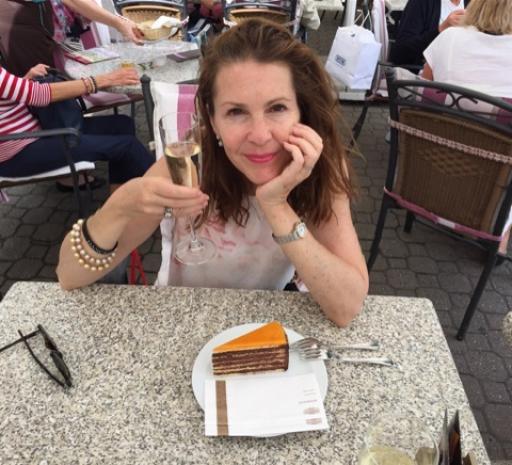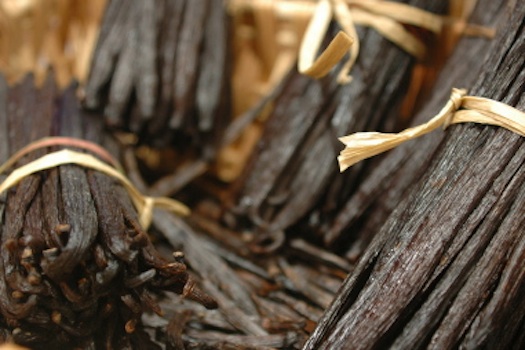
Recently Rated:
Vanilla-chocolate's jungle sidekick

When you think about vanilla, you might picture the familiar brown bottle of extract next to a bowl of butter, eggs, sugar, eggs and flour. Chances are you can practically smell the vanillas potent fragrance -- warm, earthy and resonant with cherished memories of cookies past. If you were to taste a pinch of the cookie dough, you would notice the completeness vanilla provides the sweet brown sugar and rich butter . But describing the actual taste of vanilla is not easy. Its aroma is deep and earthy, but theres nothing musty about it. Its not floral like a rose or citrusy like a tangerine. We know vanilla as an important flavor component in irresistible sweets, but by itself, vanilla is not sweet at all. What, exactly, is vanilla?
A flower, a fruit, a bean, a mystery
Vanilla comes from a rare, light-green flowering orchid native to southern Mexico - the same region in which chocolate was first cultivated. The climbing rain forest vines sprout delicate blossoms, which then turn into long seed pods. The vines grow in the shade of large, leafy tropical trees like cacao and banana, deep in the forests of Guadeloupe, Indonesia, Madagascar, Mexico, Reunion (an island that's a French territory in the Indian Ocean) and Tahiti. The orchid flowers blossom briefly, and once pollinated, nine months pass before the seed pods reach maturity. When these seed pods are harvested, dried and cured, they become the dark brown beans from which we derive our vanilla (the seed pods are referred to as vanilla beans because they resemble green beans). They are sold in bundles and graded for quality.
One of the reasons vanilla is rare is because the flowers blossom only one day a year, and only for a few hours. Many orchid varieties exist throughout the world (more than 35,000 different kinds!) but only one produces edible fruit -- the vanilla planifolia. The flower can only be pollinated naturally by the tropical Melipona bee or a few species of ants and hummingbirds native to Mexico. Since these species evolved together, the insects and birds understand that they must approach the flower at exactly the brief moment it is open. This kind of restriction does not make cultivation easy, so today, vanilla farmers pollinate the flowers by hand. Once the pod ripens on the vine, it must be carefully plucked so that the base of the flower can generate new blossoms and thus, new pods. The seed pods are then dried on mats under the tropical sun, carefully steamed, turned and dried again.
The high demand for vanilla from industrial food producers, perfumers, home cooks, extract makers, cigar makers, soda companies and liquor manufacturers outstrips regional farmers abilities to produce enough vanilla beans. Synthetic vanilla (called vanillin, which confusingly enough is also the name of the chemical compound that gives real vanilla its flavor) is made from clove trees, waste paper pulp or coal tar. While the synthetic version of vanilla is widely used in mass production, it is inferior to natural vanilla, especially for premium culinary and aroma therapeutic use.
The finest vanilla in the world is still harvested in Mexico because of the growing conditions necessary for this timid orchid to thrive, and perhaps because a connection still exists between the Mexican people (particularly descendants of the Totonac tribe) and the native fruits of their land. The capital of vanilla production is Papantla in Veracruz, also known as the city that perfumes the world.
How to buy and split vanilla beans
The spice section of many grocery stores now carry vanilla beans, usually packaged in airtight glass vials. Look for beans that are dark, plump and shiny, not dried out. Other sources include Surfas in Los Angeles, or online: Vanilla Store , Nielsen-Massey Vanillas , Rodelle Vanilla or Boston Vanilla Bean Company . (Online prices are usually less expensive.)
To get the seeds out, place the vanilla bean on a cutting board and hold one end down with one thumb. Puncture the top of the bean near your thumb with the tip of a sharp knife and slice it all the way down, then pry the pod open with both hands. Next, hold the bean down at same spot with your thumb, split side up, on the cutting board. With your other hand, hold the paring knife with the back of the blade pressed down on the inside of the pod and scrape all the way down. The sticky black little dots that collect on your knife blade are your precious vanilla.
Making your own vanilla extract
Making homemade vanilla extract is a snap, and this version, which uses dark rum in addition to vodka, produces a rich, fragrant extract with intense depth of flavor. Take a large mason jar (16 ounces) and fill it halfway up with Myers's Dark rum. For the other half, use a vodka of your choice. Take 10 vanilla beans, split them, remove their seeds, and place both the seeds and the seed pods into the rum and vodka mixture. The chemical process necessary to remove the full flavor from the pods takes about three months. Store the jar in a cool, dark spot and shake it occasionally as you wait for the flavor to emerge.
To replenish your extract supply, you can re-purpose any vanilla beans you use for other recipes such as custards. Simply rinse them in warm water, dry with a paper towel, and place them back into the jar of extract. When the jar is halfway gone,, just add a half and half mix of rum and vodka to replenish the alcohol. By consistently replacing the vanilla and alcohol, you can keep the same jar fragrant and ready to use indefinitely.
Article from Zester Daily ( www.zesterdaily.com ); Photo: Good-quality vanilla beans make wonderful homemade extract. Credit: Yula Zubritsky
